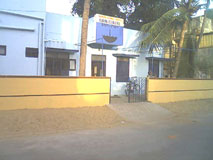|
The Rain Centre
4, Third Trust Link Rd. Mandavallipakkam Santhome, Chennai Tel: 2461-6134. Contact: Sekhar Raghavan sekar1479@yahoo.co.in
|
Akash Ganga opens Rain Centre in Chennai.

July, 2002: Rain Centre is a model house located in the Santhome beach area of Chennai to demonstrate different working models of Rain Water Harvesting (RWH) to the residents of Chennai. Rain Centre is open to the public, and there are no entrance or admission charges. Visitors to the Centre will see actual RWH systems in action, get help in designing specific RWH systems for their homes or other commercial buildings, locate suitable masons and plumbers, get an estimate of costs to install the RWH systems.
The Rain Centre is a one-story house located in Mandavallipakkam. It resembles any typical house in Chennai. The types of RWH designs installed in this Rain Centre are the most relevant ideas to Chennai's conditions. The Centre is run by Akash Ganga, a grass-roots citizen effort started in July 2001 by bringing together a number of local RWH activists. In the fall of 2001, this group helped to conduct campaigns in Chennai to promote RWH.
Chennai gets about 51" of average annual rainfall. The actual rainfall during the 2001 season was close to 70". Most of this rain falls during the monsoon months (Oct-Dec). To store the water in storage tanks or sumps during the 3 months so that it will meet the entire year's water requirements, the storage tank will need to be very large. It actually makes sense to collect the rainwater and charge it to the underground instead.
 In many parts of Chennai, the traditional wells had dried up years ago.
People then resorted to drilling deep and installing bore wells. Some of
these bore wells go as deep as 200 feet and more to find water. How long
can we expect to get water from these bore wells without replenishing the
water sources? Recharging the ground with rainwater helps to refresh the
water resources. In many places close to the sea, recharging the ground
with rainwater arrests the invasion of salty seawater in the underground.
In many parts of Chennai, the traditional wells had dried up years ago.
People then resorted to drilling deep and installing bore wells. Some of
these bore wells go as deep as 200 feet and more to find water. How long
can we expect to get water from these bore wells without replenishing the
water sources? Recharging the ground with rainwater helps to refresh the
water resources. In many places close to the sea, recharging the ground
with rainwater arrests the invasion of salty seawater in the underground.
Rain Water Harvesting involves a number of different things, including storage for later consumption, or immediate use. Depending upon the soil conditions and type of building, there can be many variations to the RWH design. The simplest design consists of collecting the rainwater from the building roof-top, ground level surfaces, filter it through a chamber of bricks and sand, then using a percolation pit, recharge the underground. Prior to this, we can fill up available wells, baby wells and sumps with water for immediate consumption.
These RWH designs are on display at the Rain Centre.
- Rooftop RWH
- Surface water RWH
- Collect rainwater flowing to the gate
- Use RW for immediate use
- Filter water and charge into the well, sump, baby well
- Percolation pit to allow water to flow through the clay soil
The average water requirements per person are 135 litres per day. For a family of 5, this translates to an annual demand of 246,375 litres. In a typical house plot of 1 ground or 2,400 sq.feet in Chennai, if we capture about 90% of the annual rainfall, it will amount to 229,950 litres. With some water conservation programs, the captured rainwater can meet the entire annual requirements.
Ram Krishnan
July 2002
- Related article: Raining good results
- Environmental Issues Homepage
- Feedback: Tell us what you think of this article.
